Five years after its debut, the PCI Industrial Computer Manufacturers Group (PICMG®) has now released revision 2.0 of the COM Express™ COM.0 Computer-on-Module standard. COM.0 Rev. 2.0 addresses the new functionalities that Intel®, AMD, and other manufacturers are integrating in their upcoming processor families. Rev 2.0 adds two new pin-outs that make space for possible future technologies by dropping a number of interfaces that are less useful. The growing significance of graphics and displays is evident in the changes made to the COM Express™ specification. These optimizations now make smaller COM Express™ form factors possible. Even with the changes to the specification, the pin-out types produced to date will continue to be available with new generations of chips, thereby ensuring the scalability of existing applications.
By Gerhard Szczuka, Product Marketing Manager Computer-on-Modules, Kontron
In the COM Express™ COM.0 specification, the PICMG® defines the standard for a Computer-on-Module (COM) as a bootable host computer in the form of a single large-scale integrated component. The vendor-independent specification of interfaces and form factors for Computer-on-Modules gives designers and solution providers a firm basis on which to develop products for the market that are future-oriented and promise long-term availability.
PICMG® continues along the right path with the Rev 2.0 of the COM Express™ specification. OEMs that set up their medical diagnostic apparatus, industrial robots and vending machines, test and measurement applications, POS and kiosk systems, surveillance cameras, or unmanned vehicles on COM Express™ modules have chosen a sustainable and innovative solution for the future. When these designers elect to migrate to a more compact form factor, COM Express™ COM.0 Rev. 2.0 will afford them a seamless transition, thanks to the newly specified compact form factor (95mm × 95mm). Kontron has offered the compact form factor under the registered trademark microETXexpress® since 2006.
A change that is a little less apparent but that has a great impact is the addition of two new pin-outs to the five already defined pin-out types within the COM Express™ specification. Seven pin-out types are now defined in Rev. 2.0. These can be split into two groups differing initially in the number of connectors they utilize. Pin-out types 1 and the new pin-out type 10 utilize the single A-B connector that has 220 pins, which can also be found on all other pin-out types. But types 2, 3, 4, 5, as well as the new type 6 also use the second 220-pin connector – the C-D connector – so they possess a total of 440 pins.
Let’s now look at the features of the individual pin-out types as specified in COM.0 Rev. 2.0.
Taking stock – pin-out types 1 through 5
Pin-out type 1: This has one 220-pin connector – the A-B connector – and supports up to eight USB 2.0 ports, up to four SATA or SAS ports, and up to six PCI Express Gen1/Gen2 lanes. It supports dual 24-bit LVDS, an HDA digital audio interface, Gigabyte Ethernet, and eight GPIO pins. SPI is added to all single pin-out types in Rev. 2.0 on previously reserved pins. (We will go into this issue in more detail later in this paper; see the section on External BIOS-Boot). The primary input voltage is +12V and standby is +5V. Some solutions such as Kontron’s COM Express™ module allow a variable input voltage.
Pin-out type 2 has all the stated functionality of type 1, but adds a second 220-pin connector to it as well (C-D). In this case, type 2 features a 32-bit PCI interface plus IDE ports to support legacy PATA devices such as PATA HDD and CompactFlash memory cards. There are a total of 22 PCI Express lanes (six on the A-B connector and up to 16 on the C-D connector), 16 lanes on the second connector being intended for PCI Express Graphics (PEG). The maximum power consumption, previously defined as 188 W, is now matched to 137W in Rev. 2.0, thanks to ever more energy efficient processors.
Comparing pin-out type 3 to type 2, only the IDE pins are used in favor of extra Gigabit Ethernet capability. Consequently, it has no legacy interfaces, but now supports up to three Gigabit Ethernet channels. In pin-out type 4, again compared to type 2, pins reserved for PCI are reallocated, creating space for ten additional PCI Express lanes. These can be used as PCIe lanes 0-15 or as second PEG port lanes 16-31.
Pin-out type 5 fuses the changes in types 3 and 4 as compared to type 2.
Pin-out type 6 opens up a new world of graphics
PICMG® has added a sixth type of pin-out to the COM Express™ standard especially to utilize the expanded graphics possibilities of new processor families. This pin-out type is essentially based on type 2, the most widely adopted COM Express™ COM.0 pin-out type to date.
Legacy PCI pins are now used to support the digital display interface and for additional PCI Express lanes. Furthermore, in pin-out type 6, the pins previously assigned to the IDE interface in pin-out type 2 are now reserved for future technologies still in development. One of these technologies could well be SuperSpeed USB, because the 16 free pins would offer sufficient lines to implement four of the eight USB 2.0 ports as USB 3.0 ports that each require an extra pair as compared to USB 2.0.
Extensive support for additional display interfaces
Although pin-outs type 2 and 6 are very similar, pin-out type 6 adds extensive support for additional display interfaces. The graphics options have always been one of the special strengths of COM Express™ through support of PEG that has been chosen by Intel® to provide a high-speed bus for external graphics cards. But these days it is not only a matter of satisfying the growing need for performance, but of supporting different output devices as well. And these are precisely the kind of requirements for which pin-out type 6 has been scaled.
Like virtually all the other pin-out types (except type 10), pin-out type 6 continues to support the familiar analog VGA, the standard interface for RGB/CRT devices used in many industrial applications. Because of the analog transmission of the picture signal, VGA is not entirely suitable for modern TFT displays with resolutions of more than 1280×1024. LVDS (low-voltage differential signaling) devices can also be driven directly by all pin-out types. This is important for applications with LCD displays, for example, which mainly use this transmission standard. Here it should be noted that the dual 24-bit LVDS channels are designed for one display; the second channel serves solely to process the increasing data rates caused by higher resolution and frequency. The connected LVDS display defines how many channels are needed for each resolution.
From SDVO to DisplayPort
Pin-out type 6 goes far beyond these graphics options. It offers three new ports that are dedicated to new digital display interfaces (DDI). The developer can configure these ports individually for HDMI (high-definition multimedia interface) respectively the electrical compatible DVI (Digital Visual Interface) or DisplayPort (DP). DDI port 1 supports additionally SDVO (serial digital video output).
SDVO is not multiplexed on the PEG port in type 6, which has been possible under the pin-out type 2 definition. Thus, in parallel with embedded graphics, an external PEG graphics card can be used, for example, for multi-monitor applications with more than 4 screens or for data processing using general purpose GPUs (GPGPU).
With the SDVO interface supported by Intel® chipsets, COM Express™ is flexible in supporting a wide variety of graphics signals. So the developer can now implement DVI (digital visual interface), for example, and achieve relatively low cost integration of digital monitors and dual display solutions. COM Express™ previously did not officially support SDVO, but it has also become part of the COM Express™ standard in the new COM.0 Rev. 2.0.
Graphic Layout:
1. VGA
2. LVDS
3. DDI -> SDVO;DP;HDMI (TMDS)
4. DDI -> ;DP;HDMI (TMDS)
5. DDI -> ;DP;HDMI (TMDS)
The developer can also operate modern DisplayPort and HDMI/DVI graphical interfaces through the DDI. DisplayPort is a universal and – unlike HDMI – royalty-free interconnect standardized by VESA, which should ensure its widespread popularity. DisplayPort not only has a much higher data transfer rate of 17.28Gbps (compared to 2.835Gbps with LVDS and 4.95 Gbps with DVI), but also a micro-packet protocol, allowing simple expansion of the standard. Furthermore, DisplayPort supports an auxiliary channel that allows a bidirectional connect to control devices by VESA standards such as E-DDC, E-EDID, DDC/CI, and MCCS. This enables genuine plug & play operation. The auxiliary channel can be used for peripherals such as touch-panel displays, USB connects, cameras, microphones, etc.
DisplayPort could eventually replace HDMI, popular on the consumer market, which as mentioned above is also supported by the COM Express™ standard on the DDI. HDMI is an ideal solution for AV and multimedia applications, such as home theater PCs or set-top-boxes, due to its high data rate, its connector concept (audio and video on one cable), and its backward compatibility. However, this interface was not developed for the embedded market. Its implementation does not make for a particularly stable solution, plus long-term availability could also be a problem as with drivers or mechanical requirements frequently change.
With this extensive support for the new graphics and display functionalities of upcoming chipsets, pin-out type 6 is a promising follow-on to pin-out types 2 and 3 and comes at the right time. Kontron already anticipated this development in a number of areas, so developers who want to make full use of the new graphics possibilities of COM Express™ are well served by the embedded specialist. Given its experience, Kontron can provide developers with optimal support when migrating from pin-out types 2 or 3 to pin-out type 6 and help to ensure a seamless transition. So, with the ETXexpress®-AI, Kontron also presented one of the first type 6 modules in the basic form factor.
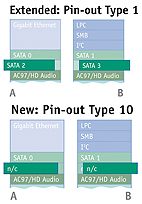
10 for 1
The major innovation that COM.0 Rev. 2.0 represents is the definition of the new pin-out type 10, a kind of twin brother to pin-out type 1. Type 10 addresses the requirements of newer and highly compact processors more explicitly. A close look at the pin assignments reveals the differences to watch out for when migrating from type 1 to this new type, although both pin-out types are compatible with each other.
In pin-out type 1, SATA ports 2 and 3 are assigned pins in rows A and B, but these are no longer reserved in pin-out type 10. The pins could still be used as SATA ports, but are now reserved for alternative purposes such as USB 3.0. So in designs for pin-out type 1 as for type 10, Kontron advises against wiring SATA 2 and 3 over the module connector. The modules then remain compatible, and they are ready for USB 3.0 at the same time. Table 1 indicates the differences.
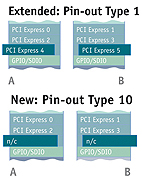
The above table shows another difference in rows A and B, this time regarding the pinning of the PCIe lanes, where pin-out type 1 offers six lanes in total.
In pin-out type 10, the pins for PCIe lanes 4 and 5 are no longer reserved and can also be used for upcoming technologies. The background in both the above cases is as follows: Processors of a small form factor, at which type 10 aims, support up to two SATA interfaces and four PCIe lanes. The vacated pins on the module connectors of the ultra standard can therefore be used efficiently for new purposes.
As of COM.0 Rev. 2.0, serial ports are again supported. The pins for this were previously used for VCC 12V.
What is new is that with COM.0 Rev 2.0 Type 10 and Type 6 support serial ports. The pins were formerly used for VCC 12V. However, dedicated manufacturers like Kontron ensure compatibility with existing carrierboards by a protective circuit on the module. Developers do not have to completely modify their existing carrier board layout, but can cost- and time-efficiently use the new possibilities.
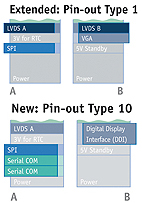
A further difference is that type 10 uses the second LVDS channel, TV out and VGA to support the SDVO port (or alternatively DisplayPort or HDMI/DVI) via DDI. That is no real loss seeing as VGA will only play a minor role in future. But now type 10 ultra-compact modules (such as the nanoETXexpress-TT) provide native support not only for latest display interfaces but also for dual independent displays, since they will continue to support an LVDS channel. Table 3 shows the precise differences in pinning between types 1 and 10.
For customers that already use the ultra compact nanoETXexpress modules from Kontron these differences are not likely to be of much consequence: With foresight, Kontron has already reserved the appropriate pins for SDVO support, for instance, on the former VGA and second channel LVDS pins in its nanoETXexpress-SP modules.
Other changes
Further changes affecting all the types of modules available are as follows: The COM Express™ connector in the present form is now also approved for PCI Express Gen2 signals. Technically speaking, that means no alteration to the connector or its pinning, but the developer must still adhere to new rules for PCIe Gen2 when routing the module and carrierboard. Additionally, the AC97 pins are now used to support AC97 and HD audio. Kontron users will already be familiar with this as the majority of Kontron COMs support these audio features.
The following changes have additionally been made in the new version: COM modules type10 and type 6 now also support SDIO, multiplexed on the existing GPIO signals. Optionally, two 3.3V TTL serial ports are added – as required by many legacy applications – and here the standard again shows its flexibility in responding to the needs of the market. Both ports can be used for different purposes such as RS232, RS485, the CAN bus, or other two-wire interfaces.

External BIOS Boot
One change shown in the new specifications affects all pin-outs: In addition to the previous firmware hub, there is a new BIOS respectively firmware interface for an internal and external boot implemented in the new generation of processors. This is a serial peripheral interface (SPI), the future interface for firmware flash on the module and carrier board. Ready reserved pins are used for this purpose.
Generally, PICMG® allows a choice between two SPI chips, the new COM.0 Rev. 2.0 specifying external firmware support for all module types. The LPC interface was used for this purpose in the earlier version.
The new modules must support SPI, but may still additionally flash firmware externally through LPC, i.e., if the chipset continues to support it. The reason for this change in firmware flash is that the new small form factor processors only support SPI boot devices.
Compact form factor now officially standard
Inclusion of the smaller compact form factor in the standard is a major innovation. It means that the most widely adopted pin-out type 2 can now also be used in applications with space constraints. COM.0 Rev. 2.0 defines its dimensions as 95mm × 95mm. Aside from the reduced footprint, the physical requirements, connector placement and pin-out are exactly the same as those of the successful basic form factor.
This is another case where Kontron entered the scene early, because the company had already been producing modules with these specifications for more than two years under the brand name of microETXexpress®, and was the first one to market. Recently, Kontron introduced a new product in this module family: the microETXexpress®-XL with an Intel® Atom™ Z520PT processor and Intel® US15WPT system controller hub. This is a COM Express™ COM.0 pin-out type-2 Computer-on-Module with a compact form factor, specially developed for use in the E2 industrial temperature range from -40 to +85°C.
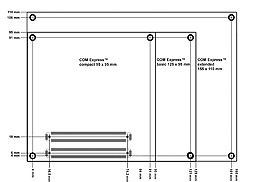
The Kontron microETXexpress®-XL with a 1.33GHz Intel® Atom™ Z520PT processor supports up to 2 gigabytes of soldered DDR2 RAM, and also has space for an onboard solid-state drive. Additionally, it makes full use of the bandwidth of the COM Express™ pin-out type 2 connector with 1 × Gigabit Ethernet, 1 × serial ATA, 1 × PATA, 8 × USB 2.0 and 2 × PCI Express, plus PCI for custom additions. With the SDVO port, it is very simple to implement a DVI output, and together with the 24-bit LVDS single channel the Kontron microETXexpress®-XL presents possibilities for connecting a whole variety of displays and monitors. This extensive feature set makes the Kontron microETXexpress®-XL one of the most flexible interface choices in Computer-on-Modules in the compact COM Express™ form factor for extreme environments (-40 to +85°C).
The latest example of the microETXexpress®-XL shows that Kontron responds to customer requirements at an early stage. The case is a similar one with the even smaller modules of the nanoETXexpress family (84mm × 55mm), for which a large demand exists on the market. Kontron nanoETXexpress modules also match the PICMG® COM Express™ standard with respect to pin assignments and pin-outs type 1 and type 10 and are ideally suited for a new generation of mobile embedded applications with low power consumption and the latest interfaces no bigger than a credit card.
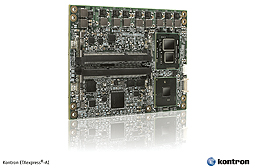
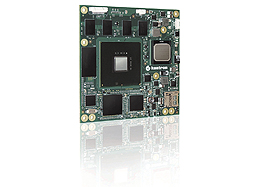
Summary
The updated specification for COM Express™ modules is an appropriate response to trends in the sector, because the standard can only be sustainable if it adapts flexibly to new demands such as miniaturization and graphics performance – as Kontron has already shown with its ETXexpress®, microETXexpress® and nanoETXexpress. Kontron will continue to develop all current pin-out types as well as pin-out type 6 and type 10 Computer-on-Modules. The PICMG® COM Express™ COM.0 Rev. 2.0 standard is for embedded developers a good indicator of what the future holds. It will create further confidence if the current PICMG® design guide is speedily matched to the new challenges.
COM Express™ is, other than the standard adopted in 1998 for DIMM-PC® and the one published in 2000 for ETX®, the only vendor-independent standard for computer-on-Modules. Thus it is extremely important in the embedded market. With Rev 2.0 it is extended by a new form factor and new pin-outs to meet future needs.
Thus the strengths of the COM Express™ concept have been preserved in their entirety: With full compatibility for existing applications, the proven standards have been adapted to the new requirements and new features of the pin-out types 6 and 10 have been implemented. That is a basis for the next few years.

Author
Gerhard Szczuka is product marketing manager Computer-on-Modules at Kontron
www.kontron.com


